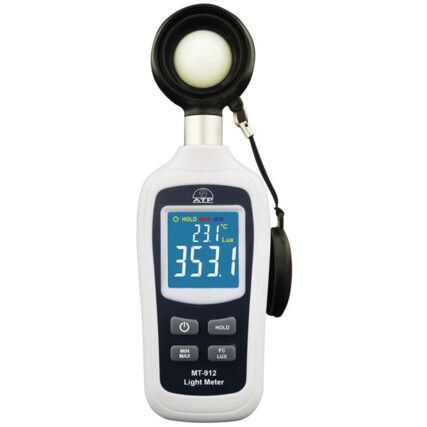Light Meters
Light meters are a vital piece of environmental test equipment that has been designed to measure all sources of light and output an instant reading. Predominantly used in the photography and lighting industry to identify correct exposure, but also used in a variety of industries and sectors to ensure regulation standards are adhered to. Cromwell have a selection of digital light meters from leading brands such as ATP, Cie and Fluke.
What are light meters?
Light meters, also known as lux meters or exposure meters, are handheld, lightweight, portable pieces of equipment that contain highly sensitive instruments that measure the level of light and output a calculated illuminance reading. They are easy to use, extremely versatile and designed to be highly accurate. They are usually housed in a strong protective casing to protect internal sensors from damage.
There are a variety of measurement units used to measure light: Candela (cd/m2), Lux (lx), or footcandle (fc).
The intensity of light (the visible light amount emitted in unit time per unit solid angle) is measured in Candela:
Candela (cd/m2) - SI base unit of the luminous intensity, which measures the luminous intensity when the light source is in a definitive direction. The SI unit of a solid angle: 1 candela x steradian = 1 lumen.
To measure the illuminance (light intensity within a space) the quantity of flux per unit area is calculated:
Lux (lx) - the standard unit of measure for light intensity. The SI unit of luminous emittance and illuminance. The formula: Lux - Lm/m^2 (One lux is equal to one lumen per square meter).
Footcandle (fc)- this is non-SI unit of measure of light intensity. A footcandle is lm/ft^2.
Why light meters?
Light meters are the most common devices used to measure all sources of light. They capture the brightness of:
• All visible sources of light - sunlight and moonlight
• Fluorescent lights
• Incandescent lights
• Metal halide and high-pressure sodium lighting
• UV light sources
• LED (Light emitting diode) lights
There are two overall types of light measured by light meters:
• Incident light (Illuminance) the amount of light falling on a surface/subject.
• Reflective light (Luminance) the amount light reflected back from a surface/subject.
When are light meters used?
Light meters are used as a tool to measure light in a variety of environments, industries and sectors for a range of functions:
• Environmental - measurement of light pollution (airports and cities).
• Workplaces - all employers have a statutory duty to ensure they provide suitable lighting within the workplace (offices, factories and warehouses).
• Public buildings, venues and spaces - must ensure lighting is adequate to abide to health and safety rules (universities and schools, hospitals, medical centres, social care, community centres).
• Architecture, building & construction - aids builders and architects to ensure they have adequately met lighting regulations and installed lighting solutions correctly.
• Agricultural, horticulture & food production - ensures ample lighting is reaching the soil to allow the plants to grow.
• Solar panels - used as a tools to find optimum position and angle.
• Photography/cinematography - used to measure the light to allow the user to determine optimum exposure. Due to advancement in technology devices such as smartphones and modern handheld cameras have a built-in automatic light meter that measures the surrounding illumination and automatically triggers the integrated flash when the ambient light is detected as low, to ensure correct exposure can be achieved.
• Lightening technicians/engineers - used to aid all lighting set and scene lighting decisions.
• Environmental & biological science - studying eco-system growth patterns of vegetation.
Light meter types
Most older models use galvanometer displays or analogue rotary dials to display readings, unlike modern models that predominantly use an LCD screen to clearly display light measurements in a digital format. Light meter devices range in features, some are equipped with an internal data memory log to record and store measurements.
FAQ
What are the advantages of using a light meter?
• Portable and lightweight
• Able to be used to measure all light sources
• Provides accurate measurements
• Instant results
Is it necessary to calibrate a light meter/lux meter?
Yes, light meters require periodical calibration to maintain accuracy as precision can decrease.



